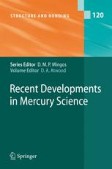Search
Search Results
-
Carbene Complexes of Heme Proteins and Iron Porphyrin Models
The possible formation of carbene complexes of cytochromes P450 enzymes in various metabolisms of xenobiotics is first described. In view of these...
-
Ferrocene–Peptide Bioconjugates
This chapter sketches an outline of ferrocene–peptide bioconjugates. A variety of ferrocene–peptide bioconjugates have been designed to induce...
-
Catalytic Nickel–Iron–Sulfur Clusters: From Minerals to Enzymes
The geochemical theory of the origin of life proposes that primordial, pre-biotic reactions were carried out in a metal-sulfide-rich environment...
-
Sequentially Palladium-Catalyzed Processes
Sequentially palladium-catalyzed reactions consist of combinations of identical, related, or significantly different palladium-catalyzed processes...
-
Structural Aspects of Layered Double Hydroxides
Layered double hydroxides (LDHs) have been known for a considerable time and have been widely studied. The basic features of their structure,...
-
n-Body Decomposition Approach to the Calculation of Interaction Energies of Water Clusters
A new methodology is proposed in which large basis set MP2-level calculations can be extended to water clusters with as many as 50 monomers. The...
-
Multiporphyrin ArraysAssembled Through Hydrogen Bonding
Although relatively weak in isolation, composite H-bonds can be used as an advantage for the assembly of relatively robust and well-defined arrays...
-
Axial Coordination to Metalloporphyrins Leading to Multinuclear Assemblies
The use of axial coordination to metalloporphyrins is discussed on the basis of constructing multinuclear complexes. Starting with single...
-
Poly(mercaptoimidazolyl)borate Complexes of Cadmium and Mercury
The coordination chemistry of bis- and tris(mercaptoimidazolyl)borate ligands with both main-group and transition metals is rapidly expanding....
-
Mercury Removal from Water
Mercury pollution in water is a serious threat to natural ecosystems. Various methods and technologies are in use to remove mercury from the...
-
Intermolecular Interactions via Perturbation Theory: From Diatoms to Biomolecules
This article is devoted to the most recent, i.e. taking place within the last few years, theoretical developments in the field of intermolecular...
-
Neurosurgical Applications
The high precision of femtosecond laser ablation makes it an interesting tool for neurosurgical applications. The resection of arbitrary-shaped...
-
Few-Cycle Pulses Directly from a Laser
Advances in ultrashort-pulse laser technology have led to the generation of few-cycle optical pulses directly from oscillators at high repetition...
-
Ultrashort Pulse Thin-Disk Lasers and Amplifiers
This Chapter deals with the generation and the amplification of ultrashort pulses in mode-locked oscillators and multipass amplifiers based on the...
-
Carrier–Envelope Phase Stabilization of Single and Multiple Femtosecond Lasers
The basic concepts, technical implementation, and known limitations of actively stabilizing the carrier–envelope phase of a few-cycle pulse train are...
-
Monolithic Silicon Light Sources
Monolithic silicon light sources (LEDs and lasers) could have a significant impact when integrated on silicon chips. After a general introduction to...
-

-
Ultrashort Pulse Lasers and Amplifiers Based on Nd:YVO4 and Yb:YAG Bulk Crystals
This Chapter focuses on the generation of ultrashort pulses and their amplification to high energies in Nd:YVO4 and Yb:YAG bulk crystals....
-
Cutting of Diamond
For a number of years, diamond has been used as a material for cutting tools. Since conventional machining of diamond is difficult and expensive,...
-
Ophthalmic Applications
Femtosecond photodisruption opens new pathways in refractive surgery due to its precise interaction mechanism with biological tissue. The quality of...
